How I Generated 23,746 High Quality Leads Using Facebook Lead Ads
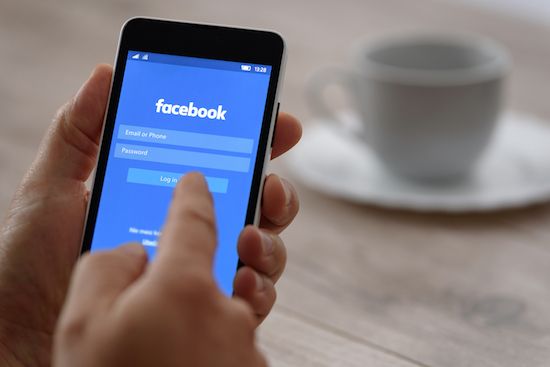
In the past few months, I have been very aggressive with Facebook Ads. I use many channels to build my email list, but Facebook Ads is the primary source. I get people into my list by enrolling students for my free digital marketing course. I deliver the course via email, and that builds a rapport on a personal level.

Some of my students who like my teaching style enroll for my paid courses. These paid courses pay the bills for the Facebook Ads which advertise my free digital marketing course. I also pay other bills like web-hosting, email marketing, etc. with the revenue from paid courses. (If you have noticed, I do not have many ads on my blog).
There are multiple entry points to my funnel. This funnel is designed to provide value and build a relationship with my subscribers. One such entry point is this blog where people can opt-in with OptinChat.com or with the exit popup. The other entry point is via ads which direct traffic to a landing page at LearnDigitalMarketing.com
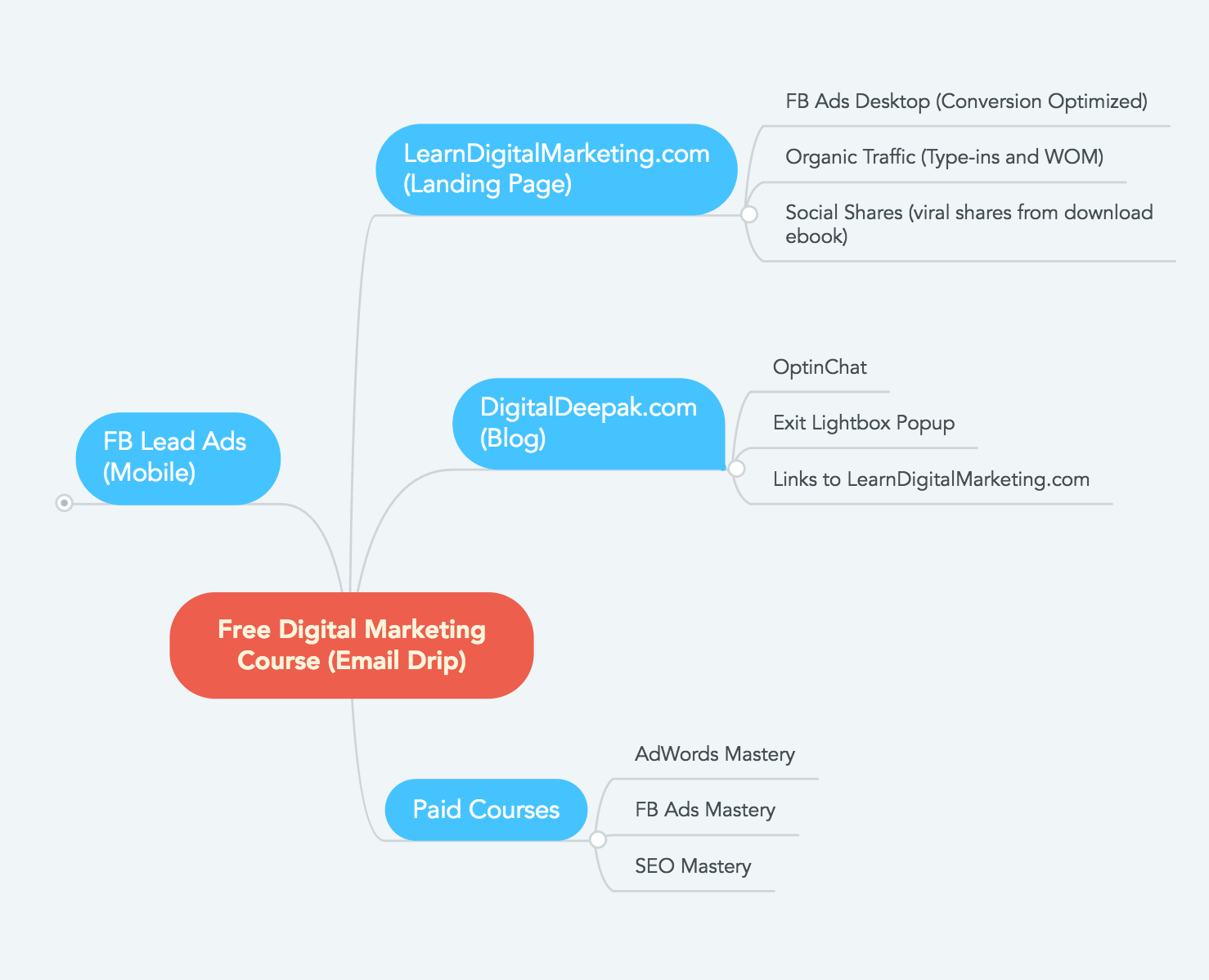
The third entry point and one of the biggest channels are Facebook Lead Ads. I generate leads directly on mobile without a website or landing page. Leads collected by Facebook are automatically sent to my drip marketing tool and people who have enrolled start getting the lessons to their email inbox.
With Lead Ads, the friction to sign up is very low because Facebook pre-fills the lead details for the end user and they become a lead with just one more click. It works great on mobile phones because filling up a form on a mobile is a pain.
As soon as someone clicks on the ad, a form like this is shown with pre-filled information. This screenshot is from a desktop, but on mobile, it would look similar and appears as a full page form.

I have been quite aggressive with all types of Facebook Ads, but with lead ads, I have put it on a full throttle because of the low pricing!
When I checked today morning, I have generated a total of 23,746 leads from Facebook Lead Ads in the past few months at an average of just $0.08 per lead! (That’s great because, in this market, 8 cents is cheap. There are other markets where you can generate leads for as little as 1 cent or even lower, but the revenue that can be made from them will also be low).
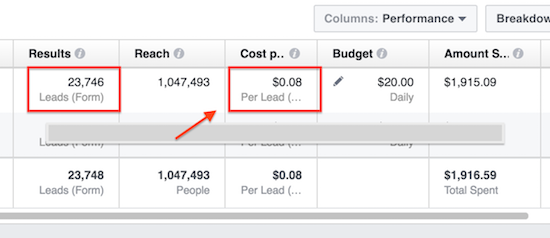
Just 8 cents. That’s Rs.5.20 per lead! When I do a course launch, I make a revenue around Rs.5 to 10 per subscriber. That means that I can take back my investment (and even get some more) in just one product launch. The revenue from next product launch will be 100% profit.
I have spent less than $2,000 for this entire campaign and generated more than 23k leads already. If I earn 10 cents per lead, I will get back $2,300+ with just one launch.
Note: One downside of Facebook lead ads is that people who sign up on Facebook do it with a different email ID and it may not be their primary email ID. So the open rate of these emails might be less. But considering the low cost, even if only 1 out of 2 leads is good, you are still getting it at a very low cost.
If you are providing something of high value to the people who sign up, they will enter their primary email ID in the form and sign up. In my case, many felt that I am providing some serious value here and they came back to my website to sign up with their primary email ID.
Your Target Audience
Advertising is all about precise targeting. If you have a great product at an unbelievable price but if you are showing it to the wrong audience, then 100% of your advertising budget is wasted.
Imagine showing high-quality women’s handbags at an unbelievable price to an audience of men who are 30-40 years of age. You will hardly get any conversions except for a few cases like buying it as a gift for wife/girlfriend. The right audience targeting is not just powerful but necessary to stay ahead of your competition.
Long back when there was no internet, no marketer had this level of targeting prowess. Advertisers used to advertise on TV, Radio, and Newspapers which have almost no targeting options. Magazines had narrower targeting because they are categorized and hence magazines used to charge a lot more than other media for the same reach.
Something like Facebook Ads is a dream come true for marketers. With so many targeting options available inside Facebook, you will have tiny spillover with the ad impressions. This leads to high CTR, high conversions on the landing page and high engagement. My ads get as much as 2.5% CTR and landing pages get as high as 55% conversions.
The general targeting options available inside Facebook is interest based and demographic based. But you will be surprised to know that I do not use those targeting options!
Instead, I use Facebook Pixel to tag all my website visitors and subscribers. These subscribers have come from organic search and other organic channels.
Then I build a lookalike audience inside Facebook. This audience matches the demographics and psychographics of the people who have subscribed to my course already.
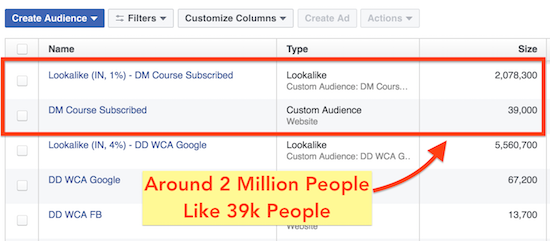
I run an ad for my free digital marketing course to the lookalike audience and also exclude the individuals who have already subscribed for my course.
You have to make sure that you do not make your targeting too narrow. Narrow targeting starts with affordable lead costs but then goes up once the audience is exhausted. Broad targeting starts with higher cost but will keep the lead cost stable for a longer period. Broad targeting is important when you want a lot of leads and customers. Read more about it here: Why Does Your Facebook Ad Cost Increase Over Time?
Your Ad Image
Next to targeting, the most important factor for the success of your ad campaign is the ad copy & the ad image. Facebook is a visual medium and photos perform very well. The ad should contain a very engaging and contextually relevant image. That’s the most important factor governing the CTR of the ads.
Here’s my ad image. It is recommended that you do not have any text in the image. Though Facebook allows you to have 20% text on the ads, the CPM of the ad goes up when you have text in the image. (That was a secret, I just revealed it!)
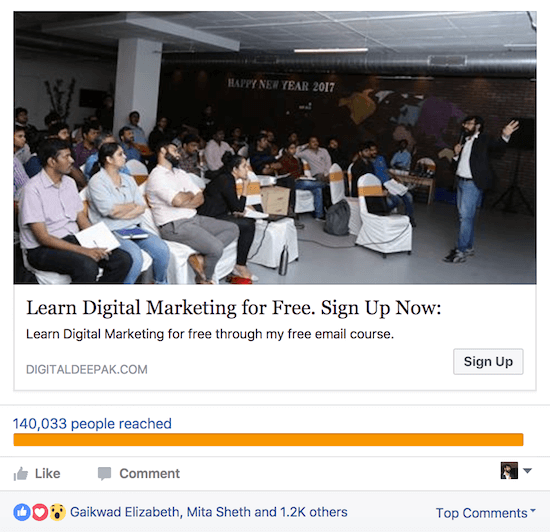
So, I would recommend that having an image with no text is the best. Even if your image with text is getting a higher CTR, your CPM might be high as well. So if you can get a lower CPM with an image with no text and let go a small % in the CTR, end of the day, your CPC will remain the same, and the quality of the clicks will also be high.
Let me explain with an example:
Case 1:
- CPM is $2.5
- CTR is 2%
- You get 1,000 impressions
- So you get 20 clicks
- CPC will be $0.125
Case 2:
- CPM is $2 (because of no text in the ad image)
- CTR is 1.6% (lower CTR because of no text in the ad image)
- You get 1,000 impressions
- And you get 16 clicks
- CPC will still be $0.125
Since your CPC remains consistent, your lead cost and cost to acquire a customer will also remain constant. And you will get more quality clicks in Case 2 because you are eliminating 98.4% of the people (and getting only 1.6% CTR) while only eliminating 98% of the people as in Case 1.
To understand this: imagine having a very flashy ad which gets a CTR of 4-5%. Here you will get a lot of accidental clicks by people who are not very interested in your offer and hence your landing page conversions will also go down). So when your CPC is consistent, you should try to get as low a possible CTR to keep the traffic quality high.
I had a different ad with a different image in the same campaign previously, and the cost per lead was around $0.11 in that campaign. It had a generic image with text. I replaced it with another image without text, and still, it did not perform that well. When I created this ad (shown above), I used a photo from the workshop that I conducted recently, and it started performing brilliantly well.
An image with me speaking in front of an audience positions me as an expert/authority, and hence the CTR has gone up. I was not completely aware of this fact before, but after updating the ad with this image, it became apparent.
The Ad Copy
Most of the advertisements that you see on Facebook have a very short Ad Copy. In my experience, a longer copy has always performed well and gets more quality clicks than short copy. This is particularly the case when you are reaching a virgin audience. People clicking on ads with short copy don’t have much information about the offer and hence the targeting is a bit off and quality of traffic is low.
You might think, who reads a long copy? I agree. Most of them will not read a long copy. In fact, around 95% are looking for ‘snacking’ content on Facebook, and for them, Buzzfeed and ScoopWhoop provide enough content.
The people who will read long ad copy may be just 5%, but that 5% is your target audience. Your best customers are in that 5% who will read a long copy because they want to know more about your offer. With a short copy, you are not giving your potential future customers enough to know more about your offer. And you may lose them with a short copy!
One of my earliest ads just had one line of text. It said ‘Learn Digital Marketing for Free’. My latest ad copy is as long as a blog post!
I tried to add a screenshot of the most recent ad, but it was so long, that I couldn’t take a screenshot even with zoomed out setting on Chrome browser. I increased resolution, and still no luck.
I connected an external HD monitor, and I still couldn’t get the ad copy on one screen 🙂
I had to make my external monitor vertical and change the orientation to get this photo!
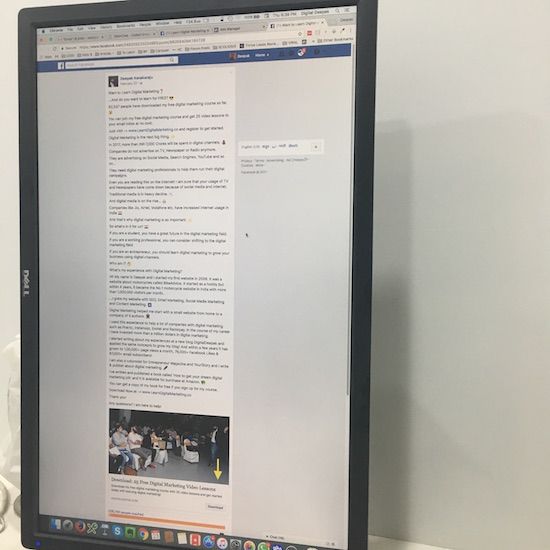
That’s how long my ad copy is and that’s the extent I can go to make you understand that long ad copy is REALLY important.
It’s not just in my experience, but many leading copywriters agree that long ad copy has always performed better than a short, branding style ad copy. This is especially true for direct response marketing.
And now, don’t worry that every marketer is going to read such a long ad copy and start getting results as good as us!
You are here at the 1644th word on this article and 95% of the people who opened this page did not make it up to here! Just like the 95% of the people who do not read your long ad copy. 🙂
I can bet on this fact that 95% of the people don’t read long form content. If you want me to prove it, click on this link which leads to the top articles page on my blog. The And after a week or so, I will post my total visitors from Google Analytics to this page vs. the number clicks I’ve got for this link! I am sure it will be as low as 2%.
The Relevance Score
Now that we have got some real clarity about your ad image and the ad copy let’s look relevance score. A high relevance score is required to have a low CPM and hence keep your CPC and Lead costs low.
The Relevance score is simply a measure of how relevant and useful it is for your target audience. Relevance score will go down with bad targeting, bad copy and bad image.
Facebook is a native advertising platform, and our ads appear like regular content on Facebook feed except for a small grayed-out word ‘Sponsored’ below the name of the page. So Facebook wants to make sure that their users get interesting, relevant and quality ads on their feed. If most of the ads are irritating, people might not use Facebook as much.
If you have a compelling ad copy, good clear image, and perfect targeting, users will find it useful. The best sign of people finding your ad is useful is when they share, comment and like the post.
Inside Facebook Ads Manager, you will be able to see the relevance score of your ad. You will also get details about the level of positive and negative feedback that your ad gets. You will be able to bring up these columns from the Columns -> Customize Columns section.

You can see that my ad has got a relevance score of 9. There are times when I have got 10 as relevance scores, but I have to target even narrower, and that doesn’t help in scaling it to a larger audience.
Conclusion
I hope this article has inspired you to get great ad images, write great copy and start trying out Facebook Lead Ads. Many of the concepts discussed here apply to all form of ads and not just FB Lead Ads.
Also remember that with time, more advertisers are trying to reach the same audience and the lead costs will keep going up. But if you have a strong funnel and if you are getting back a good ROI, then lead cost is just a % of your revenue, you need not worry about the unit cost of the lead.
Any questions?